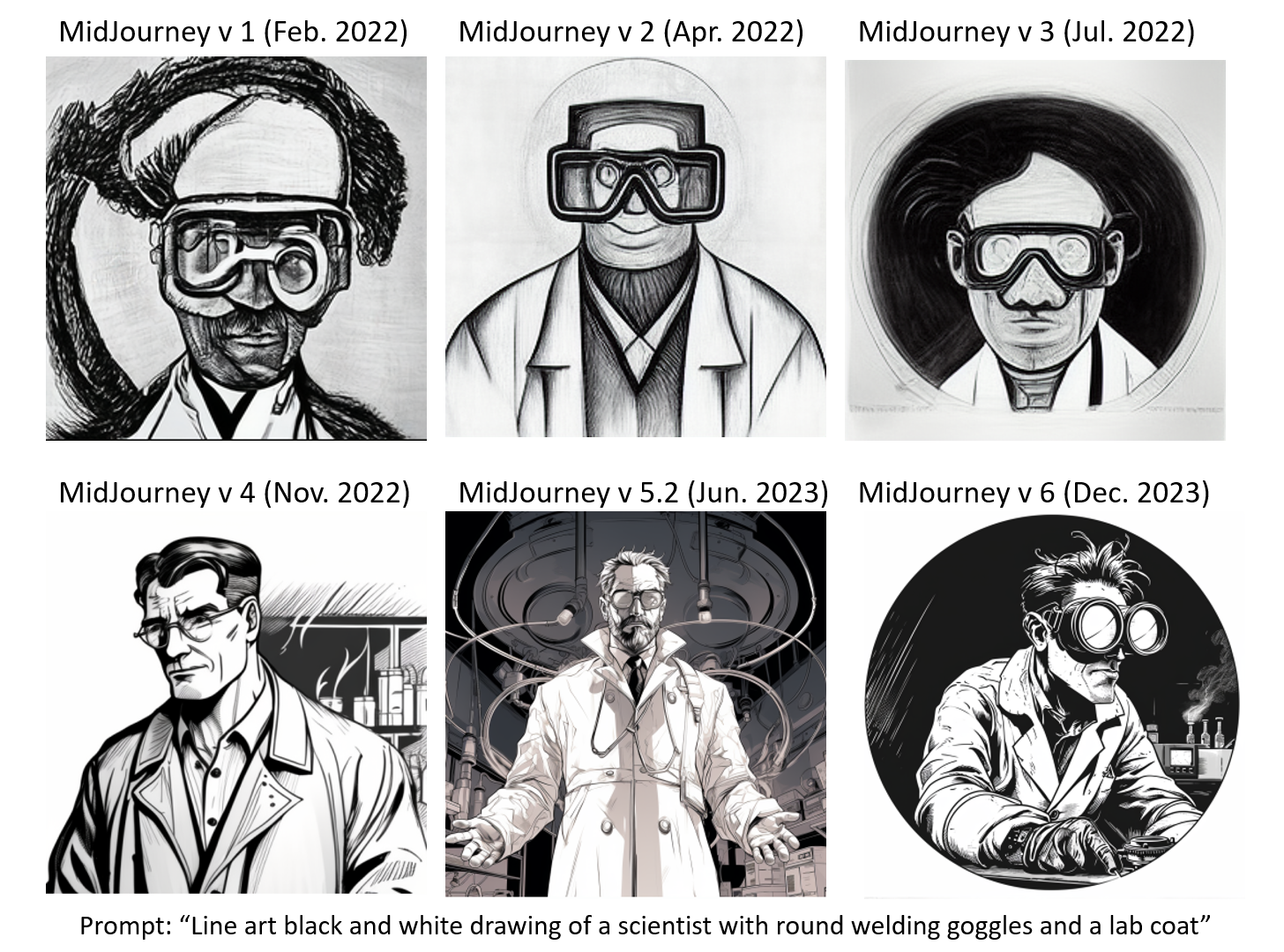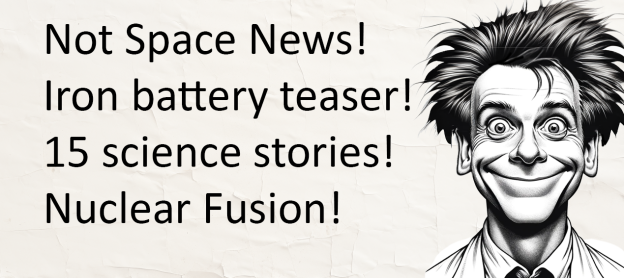Here is the science I was most excited about in 2023. It’s still January! I got it done just in time! This post is also a video. If you want this post in video format, you can click here.
I reviewed the lists of top science from Science magazine, Nature, the Guardian, as well as my notes over the year. Here are my selections. Links for all sources – lists and original articles – are at the bottom.
ENERGY
On the Iron Battery – my former student, soon-to-be doctor Koirala, took over the project in 2020 and has been working away. We’re hopeful that we will be submitting a paper soon. I will update here, too. He has significantly improved the power of the cell – more than 10x power compared to my best. I look forward to telling you all about it, but I have to wait until it’s out.
Battery research in general got a huge boost in 2023: Joe Biden’s DOE is putting $3.5B into battery research. That’s a lot of money. I’m used to seeing $100M as a big program in this field. $3.5B is vast and it’s appropriate if the USA wants to stay ahead of the curve. Good job to the Biden administration. This is a big investment in a critical area to American prosperity. American Science is definitely better off under Grandpa Joe. If you care about science, vote for Biden. Or if you can’t do that, you’re allowed to leave it blank.
This arrives on the heels of announcements of solid-state battery progress out of the University of Maryland. Solid-state batteries are potentially a big deal for battery capacity and safety. New battery technology takes a frustratingly long time to commercialize, but it has to start somewhere. Maybe with $3.5B coming into the field, time-to-market can get a little shorter.
I learned about hydrogen wells in 2023. Sometimes, boreholes for natural gas extraction hit deposits of pure hydrogen instead of methane. I was under the impression that hydrogen escapes confinement too easily for that to happen. But, apparently, there are deposits of 98% pure hydrogen for the drilling. Unlike natural gas, neither hydrogen gas leaks nor hydrogen combustion products will cause climate change.
I’ve been very skeptical of hydrogen as a fuel. Hydrogen usually needs to be made from something else. It’s more like energy storage than an energy source. You can make it from electricity and water, or natural gas (which defeats the purpose). It’s a volatile and difficult way to store energy. And it makes metals brittle when they come into contact with it. But finding vast deposits of hydrogen ready-to-use might change that outlook.
Nuclear fusion made progress, too! 2022 was the year of ignition – the first breakeven fusion pulse at LLNL. But 2023 marked progress in LLNL’s laser-induced fusion (they achieved ignition for the fourth time and set new energy records). I was also excited about the power plant progress at Helion and Tri-Alpha.
Helion announced a power purchase agreement with Microsoft. The software giant agreed to buy electricity from Helion’s first fusion power plant in 2028. That seems very ambitious, even unlikely from here, but who knows? I would love to nerd out and explain their fuel cycle. It’s exciting. Leave me a comment if you want to go over the Deuterium-
Tri-Alpha measured the first proton-boron plasma fusion products. This flew under the radar from what I saw. This fusion project hopes to do “aneutronic” fusion. That has two advantages. First, it doesn’t make weird radioactive isotopes in the reactor walls. Second, it doesn’t need a steam turbine – it captures energy like a reverse-particle-accelerator. That could make a power plant far cheaper.
BIOMEDICINE
Wegovy is a drug targeting the GLP-1 receptor. It has taken off this year. It helps people struggling with diabetes and weight loss. This was also Science Magazine’s Breakthrough of the Year. And deservedly so. I am excited to see the long-term numbers – do people on Wegovy live longer? What about their biological aging rate? Caloric restriction tends to slow aging. Will that happen to people on this drug?
Two antibody drugs have been approved (or will soon) for use fighting Alzheimer’s disease. According to Science Magazine: “Lecanemab, slowed loss of cognition by 27%… another antibody treatment that also targets brain amyloid, called donanemab, slowed cognitive decline by as much as 35% versus placebo in a slightly different patient population, and U.S. approval could come any day.” That’s not a cure, but it’s something. I’ve been watching the amyloid debate for a long time. There’s this big question of whether amyloid protein is the main problem in AD. I thought the evidence was leaning away from amyloid. But this suggests that the amyloid hypothesis still has legs.
A gene-editing cure for sickle cell disease passed a major hurdle this year. After a trial in the UK, a cohort of trial participants had many of the effects of sickle cell disease greatly reduced. Sickle cell disease is caused by inheriting a bad gene, and it is a horrible and painful condition. Scientists took some of the patient’s own cells, edited their DNA, and put them back into their bodies. The edits fixed the problem. It’s an important step.
I was also excited about a paper that covered the possibility of using Taurine for extending longevity. It’s early days, but any molecule that might buy some healthspan is welcome. I’ve been spending a fair amount of time reading the longevity intervention literature. I’m planning on more longevity content here on this channel, so stay tuned!
SPACE NEWS
India’s landed a robot on the moon. Cool.
NASA’s OSIRIS-REx probe came back with asteroid material. Also cool.
Everybody talks about space news. Go watch Niel DeGrasse Tyson – he’s charming. Let’s move on.
LK-99, THE SUPERCONDUCTOR THAT WASN’T
Even though it turned out to be a dud, it was really amazing to see science work in real time in full view of the media. I wish it had been a real room-temperature superconductor. Consider MRI machines – most of that massive instrument is the cryogenic superconducting magnet. If we had room-temperature superconductors, the instrument would be much smaller.
Consider Fusion energy. Lots of the technical barrier to massive fusion reactors is the size and expense of huge cryogenic superconducting magnets to confine the plasma. But if the magnets were just coils of room temp wire, that would simplify everything.
And consider the electric grid. It’s not economical to build solar farms in the Mojave or Sahara or Australian outback and pipe the electricity over intercontinental distances. The losses in transit are too high. But a RT superconductor power grid could send energy from solar farms on the other side of the world with no problem. The sun would never set on the world’s shared solar panel array.
But that is how science works: it is a long series of failures until it isn’t. It was great to see it work in such a high-profile case.
AI TAKES OFF
Between the chatbots and generative images, I am convinced that most AI skeptics are going to be proven wrong. Self-driving cars are not here but look at the difference in AI capabilities year-on-year. It’s going to happen. Human-level robots are on the way.
See the progress from 2022 to the end of 2023. The sample images here were all created with the same text prompt. The quality difference is EXTREME. It was barely a toy and now it’s a practical tool for making illustrations.

That brings challenges. Artists sued the image generator companies because the image generators used their training data without license or permission. The New York Times just filed a similar lawsuit against Open AI on the grounds that the Chat GPT LLM did something similar with their text data. Where will that go? Can they put the genie back in the bottle? I doubt it.
For better or worse, we have entered the age of AI. It’s solving problems in protein folding and nuclear fusion. It will solve problems in driving taxis, stocking shelves, and cleaning bathrooms soon enough. Are we ready?
ENVIRONMENT
Hottest year on record. Again. But winter still exists, so, checkmate climatologists?
It’s too frustrating. Moving on.
DIPAK’S PUBLICATION
This one is a personal story but it’s my list and I can do what I want.
I’m very proud of my former student for pushing this through. The reviewers did not make it easy, but I think it produced a good paper:
Dipak made DNA-coated carbon particles. That by itself is pretty cool. Then he used PCR to detect Salmonella DNA. The idea is that, if salmonella is present, then the short, synthetic, single-stranded DNA molecules will grow into long chunks of double-stranded DNA that he could detect.
Being able to do that in one tube seemed pretty amazing to me. However, one reviewer was skeptical. So, to prove that this was a big deal, Dipak went out and got some raw chicken, and swabbed chicken drippings into the PCR tube with his particles. No cleanup. And the particles could detect spiked salmonella DNA even in raw chicken juice. Regular PCR can’t run in that gross environment. So, for regular PCR, the samples would have to be cleaned up with a column or other extraction system.
So, I think that is pretty cool.
IN CLOSING
The algorithm doesn’t always show subscribers my videos. I set up a mailing list so I can send monthly (or fewer) email updates with links to my work. I would love it if you want to join.
EMAIL NEWSLETTER:
GET IN TOUCH
Do you have questions you would like to see answered? Drop me a link in the comments, or send me an email or voicemail. There’s a temporary email address and phone number in the description and pinned comment. Get in touch! Maybe I can use your question/comment in a future video. I will leave you anonymous unless you request otherwise.
Contact info for Science Questions:
Temporary email: comments@peterallenlab.com
Voicemail number: +1 512 487 7544
SOURCES
Science Magazine top story
Runners up
https://www.science.org/doi/10.1126/science.adn4879
The Guardian’s top 10
Wegovy
Gene editing
Taurine as an anti-aging supplement
Taurine deficiency as a driver of aging | Science
LK-99
https://www.washingtonpost.com/science/2023/08/09/room-temperature-superconductor-lk99-evidence/
https://arstechnica.com/science/2023/09/the-room-temperature-superconductor-that-wasnt/
SPACE
NASA’s OSIRIS-REx Is About to Bring Asteroid Pieces Back to Earth | WIRED
Chandrayaan-3 landing: India becomes the fourth country ever to land a spacecraft on the moon | CNN
AI in science
https://dx.doi.org/10.1038/d41586-023-02980-0
AI lawsuits
https://cacm.acm.org/magazines/2023/11/277422-legal-challenges-to-generative-ai-part-ii/fulltext
Hydrogen deposits
Battery investment at DOE
Solid State Batteries
https://www.nature.com/articles/s41586-023-06653-w
Nuclear fusion
LLNL’s NIF Delivers Record Laser Energy
Helion announces world’s first fusion energy purchase agreement with Microsoft | Helion
First measurements of p11B fusion in a magnetically confined plasma | Nature Communications
Climate
https://www.noaa.gov/news/2023-was-worlds-warmest-year-on-record-by-far
Dipak’s paper

